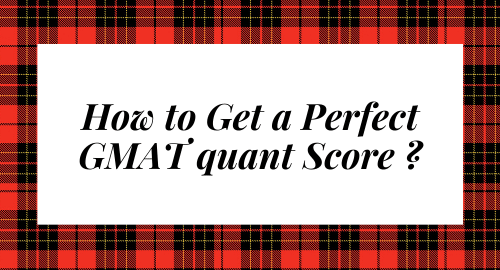GMAT is a wonderful exam that tests your critical reading (eye for detail), reasoning skills, especially on the Quant section. Before we embark on our journey to achieve a perfect Quant score on the GMAT, let’s get our statistics right first.
The Quant section on the GMAT has a scaled score from 0-60. However, the maximum score that can be practically obtained is 51. The score range of 52-60 has been reserved for futuristic purposes by the Graduate Management Admission Council (GMAC). Moreover, to obtain a perfect Quant score, it is not compulsory that every question appearing on the exam should be answered correctly. There are numerous instances of a candidate getting a perfect 51 on the Quant with three questions wrongly answered. However, there have been other instances where a candidate got a 50 even when only one of the questions was wrongly answered. So, it is anyone’s guess as to how the GMAC scoring algorithm precisely works. However, nothing should be left to luck and one should strive to answer every question appearing on the test correctly.
Furthermore, adding on to the statistics, scoring 51 on the Quant is pegged at 96th percentile, which means 3% of the total test takers achieve a perfect Quant score. What is even more surprising is that a score of 50 on the Quant section is 85 th percentile, and a score of 49 is 74th percentile. If you are eyeing the top IVY business schools, they have the luxury of not choosing anyone scoring below 50 on the Quant. So, now with the basic understanding as to why you need to perform exceptionally well on the Quant section, let’s jump straight away what needs to be accomplished to get a perfect Quant score.
1) Command over the subject:
Majorly everyone preparing for the GMAT wants to straight away jump to the advanced questions and techniques skipping the basic fundamentals. This approach may save preparation time but will cost you very dearly on the GMAT. The ideal approach should be a linear and systematic one towards the development of knowledge and skills leading to strong command in Quant.
2) Identifying alternate/efficient solutions:
One should always remember that the GMAT s a test of intelligence and not knowledge. Many of the candidates appearing for the GMAT would have scored much better if there were no time constraints on the GMAT test. This can be attributed to the fact that GMAT actually tests high school math. However, to overcome the timing issue, you need to focus on finding the most efficient solution to the particular problem which will help you broaden your horizon and prepare you for completing the Quant section in the stipulated time.
3) Rigidity with techniques:
The basic goal of the GMAT test is to test your understanding of analyzing a situation and to determine the information needed to solve it. Understanding how to approach and solve the problem is the key. The emphasis should not be on the final solution but rather your approach should be to critically think as to what GMAT expects out of that question. You need to think from the perspective of the examiner as to why the particular question appeared on the GMAT. With guided practice, the same can be accomplished. The moment you start thinking and understanding the examiner’s point of view, the dreaded GMAT will unveil its beauty and you will really start to enjoy your GMAT prep phase with a dramatic decrease in the time spent answering most of the questions.
4) Data Sufficiency Questions:
As the name implies, the main objective of Data Sufficiency questions is to determine whether the given information is sufficient to answer a given set of problem. Many candidates make the mistake of treating this section as a problem-solving section and hence consume a lot more time than that is actually required. For example, suppose we are given a question where we are provided with three sets of equations and the number of variables provided in the statement is only two. So, instead of solving the equations, we should be pretty clear that the given set of information is insufficient to answer the question. Also, candidates make a lot of silly mistakes in these questions by skimming through the question stem and not having an eye for detail which is very important for each and every question that appears on the GMAT.
If you understand the fundamental strategy to approach the Data Sufficiency questions, you will end up saving a significant time which is the most important resource on the GMAT exam.
5) Quality over Quantity:
One should practice selected quality questions rather than a bunch on mundane questions which do not increase your critical skills. The internet is flooded with stories of students who, in spite of giving repeated attempts and studying like crazy, were not able to see any improvement in their scores. This can be attributed to the widely held notion that only Practice can help you increase your GMAT score. However, what matters the most is your thinking process. How your mind processes the information when you read a question? In what circumstances it is better to eliminate than to solve? And more importantly, how fast and accurately are you able to do this in a time-pressured environment. At this point, your private GMAT tutoring takes the niche. An efficient GMAT tutor will help you get rid of all your doubts by explaining in the easiest and efficient way to solve a variety of problems.
6) Improving your Weak Areas:
Analyzing your mocks and practice test in great detail and depth is another area, which when worked upon effectively gives meaningful insights regarding your strengths and weakness. Contrary to the popular notion of playing on strengths, scoring well on GMAT specifically requires a thorough analysis of identifying your weak areas and converting them into your strengths. This is the single most key factor that marks the difference among the candidates who see a great jump in their scores on the final GMAT exam. To identify your weakness you should work with a great GMAT tutor who has years of experience behind his back teaching students of varying aptitude levels. Your tutor can use his or her expertise and can prove to be a great sailor in helping you pass the GMAT with flying colors.
7) Using Logic over Math:
To understand this deeply, we need to go to the way the brain works. Our brain can be divided into two halves or hemispheres: left brain, right brain. Both the sides of the brain look very much alike, but there’s a huge contrast in how they process information. The left brain is more verbal, analytical, and orderly than the right brain. It’s sometimes called the digital brain. It’s better at things like reading, writing, and computations. The right brain is more visual and intuitive. It’s sometimes referred to as the analog brain. It has a more creative and less organized way of thinking. Our education system has been designed to test the left side of the brain much more than the right side. People who use the left brain more are excellent in following a procedure, a specific set of rules and this is the reason you have been a great academic performer. However, when it comes to the GMAT, you might be able to solve the majority of GMAT questions using standard techniques, but that simply takes too much time, which you simply can’t compromise on the GMAT. In fact most questions on the GMAT have much shorter insight-based solution. This is where GMAT requires you to use your right brain equally effectively. The GMAT draws on both sides of the brain to be an exceptional performer.
If you precisely and diligently follow the above guidelines, there is bound to be a dramatic increase in your chances to obtain a perfect Quant score on the GMAT.
We at GMAT Gladiator advocate the assimilation of knowledge in a phased manner without rushing through, giving prime focus on the understanding and application of concepts. Once a concept is taught, we ask the student to practice a couple of questions in ascending order of difficulty on the same idea to further strengthen his understanding. We ask the student to follow his independent thought process as to how will he approach the question? Many times, though, the problem is answered correctly, but it lacks the correct approach. We narrate a more efficient way to solve the same question, thereby further expanding his horizon. In this way, the student begins to enjoy the conceptual approach seeing its benefits both in terms of reducing problem complexity and significant reduction of the time spent in answering the problem. This approach, with time, paves the way to focus on problem-solving rather than to cram. This step-by-step approach lays the foundation for a dramatic increase in his scores and overall approach to questions.
Our Alumni students all over the prestigious colleges around the world tell us how the change in their approach towards problem-solving is also helping them flare excellently in their respective courses too irrespective of the stream they chose. So, we highly recommend that you do provide us with a chance to help us nurture your talent and maximize your potential.
Our point of view – GMAT can be aced, but that surely requires the guidance of top instructors, which can effectively make a difference in your test prep.



